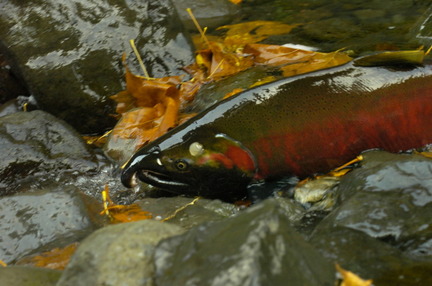 Over the past 135 years there have been many salmon recovery plans. During the past two decades their frequency has increased. The Clinton administration offered several detailed plans. The Bush administration tweaked the Clinton plans and offered several even more detailed ones. Now the Obama administration has tweaked the final Bush plan and offered its own with a few new wrinkles. Good luck.
Over the past 135 years there have been many salmon recovery plans. During the past two decades their frequency has increased. The Clinton administration offered several detailed plans. The Bush administration tweaked the Clinton plans and offered several even more detailed ones. Now the Obama administration has tweaked the final Bush plan and offered its own with a few new wrinkles. Good luck.
Not one of these plans has much of a chance of achieving its publicly stated goal. Why is it that experts, behind closed doors and off the record, pretty much agree that they will not be successful? To find out why, we need to consider what we learned from Joe Friday.
Radio, television and movie detective extraordinaire Joe Friday demanded and provided "just the facts" as he sleuthed out truth amid the gossip and hearsay of criminal investigations. Scientists (the experts) who are tasked with informing the public and policy-makers about natural policy issues should attempt to do the same -- just the facts -- the straightforward, inflexible, sometimes unpleasant realities.
Lets use a Joe Friday approach to the salmon crisis.
- Fact 1: Wild salmon in California, Oregon, Washington, Idaho and southern British Columbia are in serious trouble. South of the Canadian border, most runs are less than 10 percent of their pre-1850 levels and more than two dozen are listed as threatened or endangered under the U.S. Endangered Species Act. Similarly, several runs in British Columbia are candidates for listing under the Canadian Species at Risk Act. Worse, from California to British Columbia, many runs have disappeared, and more will follow unless there is a reversal of the long-term downward trajectory.
- Fact 2: The meager state of salmon runs along the West Coast is not a new situation. The decline in wild salmon numbers started with the California gold rush in 1848; the causes included water pollution, habitat loss, over-fishing, dams, irrigation projects, predation on salmon by many species, competition with hatchery-produced salmon and non-native fish species, and many others.
- Fact 3: If society wishes to do anything meaningful about moving wild salmon off their current long-term downward trend, then something must be done about the unrelenting growth in the human population level along the West Coast. Currently, Oregon, Washington, Idaho and British Columbia are home to 15 million humans. Assuming likely reproductive rates and continuing immigration to the Pacific Northwest, in 2100 this region's human population will be somewhere between 50 million and 100 million: a quadrupling by the end of this century, barely 90 years from now. Similarly, extrapolating population growth rates for California, by 2100 that state alone will be home to over 160 million people.
- Fact 4: If the population levels in California, Oregon, Washington, Idaho and British Columbia increase as expected, the options for restoring salmon runs to significant, sustainable levels are greatly constrained. By 2100, from California to British Columbia, there could easily be 200 million to 250 million people. With so many more people inhabiting the West Coast, consider the demand for houses, schools, stadiums, expressways, planes, trains, automobiles, coffee shops, fast-food restaurants, malls, air conditioning, drinking water, pipelines, computer chips, home entertainment systems, ski resorts, golf courses, sewer treatment plants and office buildings for government employees.
Society's options for sustaining wild salmon in significant numbers would be just about nonexistent. Good water quality would be achievable, as would maintaining prosperous populations of many non-native fish species (walleye, smallmouth bass and American shad) better adapted to altered aquatic environments, but the possibilities for abundant wild salmon would be severely constrained.
Whatever policy-makers propose to do about the 2009 collapse of West Coast salmon runs, these four facts cannot be ignored. Policy-makers should demand from scientists realistic and honest assessments of the current and future conditions for salmon.
Joe Friday was a tough, no-nonsense professional. Those of us who provide the public and policy-makers with the best available information about salmon ought to follow his lead: "just the facts."
Robert Lackey is a professor in the Department of Fisheries and Wildlife at Oregon State University and is a former senior scientist with the U.S. Environmental Protection Agency.
Facing the Facts on the Future of Northwest Salmon
The Oregonian, September 28, 2009
See what you can learn
learn more on topics covered in the film
see the video
read the script
learn the songs
discussion forum



 Over the past 135 years there have been many salmon recovery plans. During the past two decades their frequency has increased. The Clinton administration offered several detailed plans. The Bush administration tweaked the Clinton plans and offered several even more detailed ones. Now the Obama administration has tweaked the final Bush plan and offered its own with a few new wrinkles. Good luck.
Over the past 135 years there have been many salmon recovery plans. During the past two decades their frequency has increased. The Clinton administration offered several detailed plans. The Bush administration tweaked the Clinton plans and offered several even more detailed ones. Now the Obama administration has tweaked the final Bush plan and offered its own with a few new wrinkles. Good luck.
